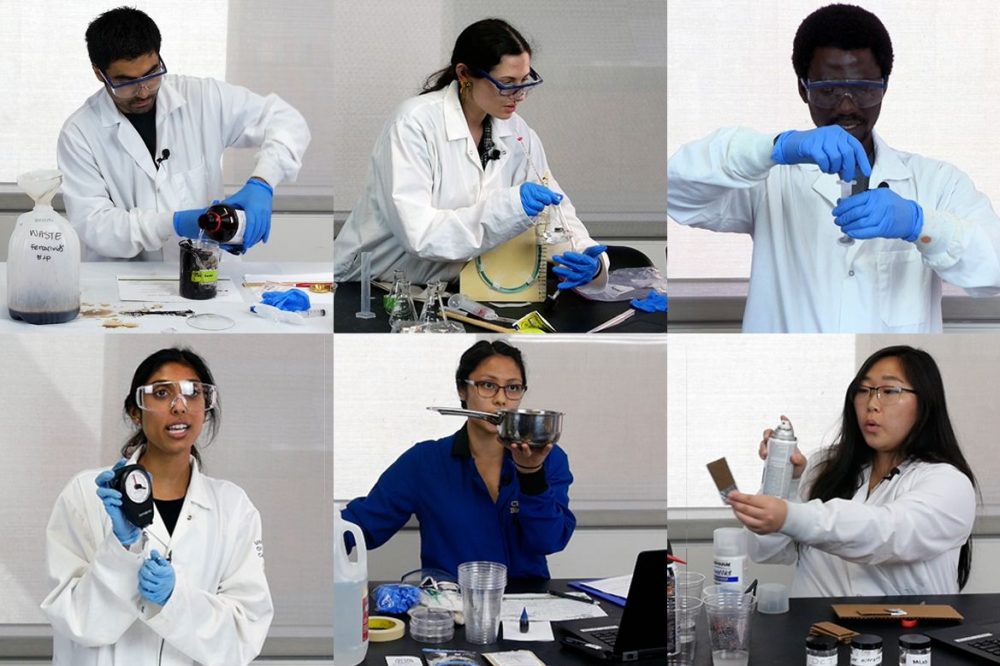By Wayne Lewis. For 16 years, the California NanoSystems Institute at UCLA has presented educational events for K–12 students and professional development workshops for teachers.
The programs, meant to excite young people about nanoscience — a field that explores phenomena that happen on the scale of billionths of a meter — have a guiding principle: “Show, don’t tell.” Many of them relied heavily on hands-on experiments and in-person demonstrations.
Then the coronavirus came along.
Because of public health measures, the faculty, staff and graduate students who make up CNSI’s education team could no longer host on-campus events or visit schools. With thoughtful planning, the educators responded to the challenge, adjusting their curricula so they could continue offering schoolchildren and their teachers the chance to learn by doing.
“For us, nanoscience education is all about hands-on experiences,” said Rita Blaik, director of education at CNSI. “To not have that would be a huge blow to what we’re trying to achieve.”
Blaik and her colleagues moved some programs online. The 2020 edition of the annual Nanovation Competition, which invites groups of Southern California high school students to dream up nanoscience-based technologies and pitch them as notional businesses, kicked off less than a week before Los Angeles County issued safer-at-home orders. Because of the health restrictions, finalists were asked to create videos of their pitches instead of presenting on campus.
► Related: High schoolers learn science and business through Nanovation Competition
As it became clear that spring outreach events would fall victim to the pandemic, the CNSI education team adjusted again. In May and June, graduate students hosted “Kitchen Science” Zoom sessions, in which they demonstrated experiments students could do at home.
A safe transition
With the summer, a larger challenge loomed. Through UCLA’s precollege summer institutes, CNSI typically hosts one- and two-week courses on campus for high school students. Holding the sessions in person was impossible in 2020, but CNSI staffers were determined to continue the program, knowing that many high schoolers were scrambling to find productive ways to spend their summer months. Although some of the traditional courses couldn’t be replicated remotely, CNSI moved one of them, “Applications of Nanoscience,” online. That meant rebuilding lab experiments from the ground up so they could be performed from home.
“Figuring out the experiments was definitely the hardest part,” Blaik said. “The summer courses are a pretty big undertaking in a normal year, and it was triple or quadruple the work this time.”
To adjust the curriculum for an online platform, Blaik worked closely with Sarah Tolbert, faculty education director at CNSI and a UCLA professor of chemistry and biochemistry and of materials science and engineering, along with a cadre of doctoral students and postdoctoral researchers.
With students doing experiments at home, safety came first. Among other adaptations, CNSI educators redesigned experiments so that students could use safer, commercially available products at home instead of riskier lab materials.
Under normal circumstances, students are divided into teams and encouraged to devise their own experiments, but that would have been nearly impossible in 2020. So the CNSI educators pivoted to a format that replicated the successful Nanovation event, with students creating pitches for new technology ideas. In the end, the course earned positive feedback from participants, with reviews about on par with those CNSI usually receives for its in-person courses.
Teaching teachers online
Each year, CNSI also holds about a dozen workshops for K–12 teachers — arming them with experiments they can replicate in their own classrooms. Those, too, moved online beginning in October — again altering experiments so teachers (and, ultimately, their students) could safely perform them at home.
The CNSI team sent teachers all the supplies they needed; for one activity, baby powder, muslin bags and dish soap were among the materials participants used to directly measure the size of nanoscale objects.
“Many people think that nanoscience has to be complex and high-tech,” Tolbert said, “but it is amazing how much students can learn and how many concepts teachers can convey using very simple experiments.”
Tolbert said CNSI’s ability to maintain its educational offerings has largely been due to the scientists- and engineers-in-training who not only do the bulk of the work developing experiment protocols, but also help organize and deliver the programs.
“Our grad students and postdoctoral volunteers have been absolutely instrumental in every aspect of the program,” she said. “Despite the fact that doing their own work has been much harder and more time-consuming during the pandemic, they redoubled their efforts to help other teachers.”
All of the efforts to move programs online during the pandemic will also have a lasting benefit for CNSI. Because online content allows the CNSI’s lessons to reach even more audiences, the education team is considering how to expand their menu of remote activities for a future in which COVID-19 isn’t an ongoing threat.
This article originally appeared in UCLA Newsroom, February 2, 2021, and is re-posted with permission in the UC IT Blog.







